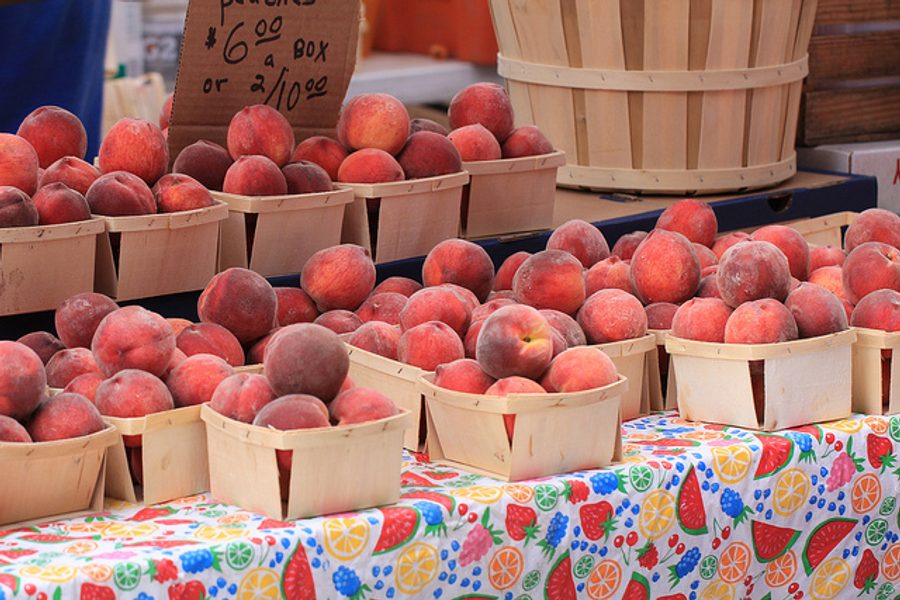
By July, farmers’ markets across the country are in full swing. But for many farmers’ market managers, the mid-season momentum turned to confusion and scramble on July 9, after The Washington Post reported that a change in government contracts could leave 1,700 farmers’ markets without the ability to accept SNAP dollars from low-income customers.
Nova Dia Group, an Austin-based tech provider, processes up to 40 percent of all farmers’ market SNAP transactions nationwide. But two weeks ago, they announced they would discontinue the service on July 31 (this deadline has since been extended by another month). While Novo Dia has largely received the brunt of everyone’s frustrations these last two weeks, it hardly seems their fault. Instead, the debacle exposes a tangle of federal, state, and private entities and a failure to coordinate government technology in a rapidly evolving landscape.
SNAP customers use Electronic Benefits Transfer (EBT) cards just like a credit card. When a customer pays for groceries with an EBT card, the transaction information is sent from the grocery store to the state processing agency, and funds are deducted from the SNAP customer’s account. With the emergence of programs aimed at encouraging SNAP customers to spend their benefits at farmers’ markets, a mobile solution for card processing had to be created. That’s where Nova Dia’s MobileMarket Plus app comes in — it’s currently the only app that works on Apple systems.
Because mobile devices were often too expensive for markets to afford, the USDA began a program in 2012 to provide free devices, including tablets and card readers, to farmers’ markets. The agency outsources the management of that program through a bidding process. Until last November, that contract was awarded to the Farmers Market Coalition, which hired tech companies, including Novo Dia, to develop the necessary software and equipment. But in March, a new $1.3 million management contract was awarded to a Virginia-based tech company Financial Transaction Management (FTM). FTM had been formed just two months previously and reports only one employee. While Novo Dia stated that they had hoped to continue as a service provider under the new management, it seems that FTM either chose not to work with Novo Dia, or was unresponsive to Novo Dia’s request to bid. Without the government contract to sustain it, Novo Dia President Josh Wiles announced they would be shutting down their SNAP processing system.
Once Novo Dia closes up shop, the 1,700 farmers’ markets outfitted specifically for Novo Dia’s system will be unable to take EBT cards, a problem that could leave thousands of farmers and hundreds of thousands of low-income customers in a lurch. Markets must now wait for FTM to roll out its new devices and software, a process rumored to take up to six months.
In the wake of the shakeup, a loud outcry from farmers’ market managers, advocates, customers, and farmers has caught the attention of officials. A statement by USDA Food and Nutrition Service Administrator Brandon Lipps on July 14 promised to “[explore] all available options in an attempt to avoid a service disruption.” Two days later, fourteen Democratic senators sent a letter to Lipps expressing concerns. “Any disruption in EBT service at these markets would have devastating impacts on SNAP families as well as farmers who sell their products to these local families,” they wrote. “We ask that the Food and Nutrition Service explore every possible option to ensure there is no disruption in EBT service at farmers markets during this critical market time.”
By July 19, a temporary solution was reached when the National Association of Farmers Market Nutrition Programs (NAFMNP) stepped in to provide Novo Dia with operational funding for an additional 30 days. A well-known nonprofit that advocates for farmers’ markets, NAFMNP says it’s committed to working with the USDA to find a permanent solution to the problem, but for now, affected markets have at least been bought another month.
In March, I wrote about how DoubleUp SNAP programs at farmers’ markets were providing much-needed economic support for small-scale growers. If a service lapse were to occur, not only would countless numbers of low-income customers lose access to food, but farmers would lose critical dollars in SNAP sales at farmers’ markets that they’ve come to count on. Adrienne Udarbe of Pinnacle Prevention, the group that manages Arizona’s statewide DoubleUp program, says that while Arizona is less impacted by Novo Dia’s departure than some other states, “even having just one market impacted is not okay.”
When Udarbe heard the news, she immediately reached out to several farmers markets in Arizona contracted with Novo Dia to offer support. She says the markets were left with two choices: Wait for the free equipment to be distributed by FTM, basically ensuring a disruption in services, or find a way to purchase new equipment on their own, to the tune of approximately $1,000 per market. The latter option means forgoing the USDA free equipment program and contracting with one of the more than 30 other companies that process EBT cards.
Through Pinnacle Prevention, Udarbe launched an emergency crowdfunding campaign to help the markets purchase new technology. The fundraiser generated private donations and caught the attention of two organizations, the Valley of the Sun United Way and Vitalyst Health Foundation, that covered the remainder of the costs. Udarbe says the Arizona markets hope to have funds in place, equipment ordered, and contracts with new companies finalized by this week.
While the Arizona markets were able to fundraise to avoid waiting for the free equipment program, other farmers’ markets may not have that option — the irony being that the lowest-income farmers’ markets are more likely to face disruptions in serving their low-income customers, because there are fewer community members with extra money to donate to the cause.
Udarbe says that any disruption in services for SNAP customers has the potential to erode a foundational element of these programs — trust. “Building trust with both farmers and families has been years in the making,” she says. “Farmers now trust that SNAP is an income source they can rely on to feed their families, and SNAP customers now put their trust in us and in the market to provide them food. When you break that trust, it does a lot of damage and there’s a lot of repair that has to happen.” Udarbe also notes the “trickle effect” a disruption could have on other incentive programs, such as DoubleUp Food Bucks, which allows customers to swipe their EBT card for $20 and receive an additional $20 from the market to purchase locally grown fruits and vegetables.
At last week’s market in Payson, the market’s co-founder Lorian Roethlein says a single mother came up to the information booth, having been sent by the Arizona Department of Economic Security (DES). After Roethlein explained how the Double Up program worked, the woman began to cry. “She said, ‘Would it be okay if I hugged you?’” says Roethlein. “People who need this program just so desperately need it.”
(“How A Questionable Tech Contract Jeopardized Food Stamps at Farmers’ Markets” was originally published on Talk Poverty. It has been reposted on Rural America In These Times thanks to a Creative Commons license.)
Debbie Weingarten is a writer and editor based in Tucson, Arizona, with a background in food systems, agriculture, and community organizing. Her journalism and creative nonfiction has appeared in the New York Times, The New York Review of Books, The Guardian, the Economic Hardship Reporting Project, Guernica, and Longreads, and elsewhere. She was a finalist for the James Beard Award in Investigative Reporting.







